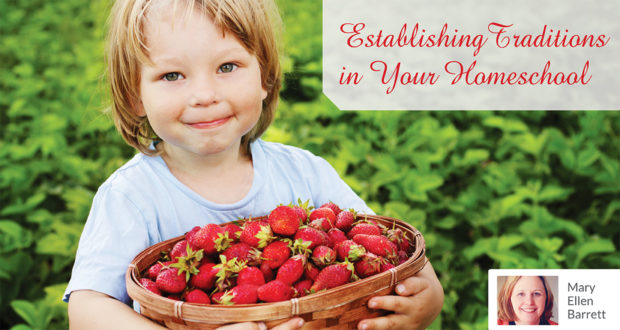Summary
Mary Ellen Barrett says family traditions are not only fun but extremely appealing to children because structure and routine are of great comfort to them.Have you ever had a bright idea to make a holiday more special by doing something a little different with the kids?
Maybe you bake a special cake or buy a little treat and next year, when you’ve forgotten all about it, you are confronted with the notion that this is now a tradition and, even though it’s 10:30 the evening before, you’d best get your tradition game on and make that happen.
The idea of tradition is extremely appealing to children because structure and routine are of great comfort to them.
When children have a solid routine in their lives, they feel secure and comforted. It’s ideal when parents, particularly of the very young, can provide a good structure for their children when it comes to bedtimes, meal times, nap times, and play times.
Carrying this forward as they get older, having good routines in school time gives them the framework to flourish in all their activities.
This is also true of establishing traditions around the Catholic faith, the changing seasons, and holidays. When we make tradition a part of the homeschool experience, we help the child feel secure.
We also give them the opportunity to love their faith or their heritage and we are passing down what is good and beautiful in the culture.
Let me share a few of the traditions that have sprung up in our homeschool over the years – small things that mark the seasons and add a little delight to the days.
Our Family Traditions
We begin school on the Feast of the Assumption (August 15th). We begin with early Mass and then a big breakfast, usually pancakes with whipped cream with blueberries. After that we look over our Seton lesson plans, and the children pick out folders and notebooks from the “generally enormous” pile that I’ve accumulated over summer.
I give them things like special pencils and pens, pretty journals for the girls, masculine ones for the boys, stickers, and a few edible treats. It’s a leisurely start to the year and we center it upon asking Our Lady for her intercession for our studies in the coming year.
After dinner I serve Assumption parfaits, which are just blue gelatin and whipped cream layered in pretty glass bowls. Healthy no, memorable yes. Heaven help me if I forget.
November 11th is Veteran’s Day here in the United States, a day in which we honor those who have and do serve this great country. It is also the feast day of another soldier, St. M
artin of Tours. St. Martin, while a soldier for France and a catechumen, saw a beggar in the road and cut his cloak in half in order to cover him from the cold.
Afterwards we pray for our own soldiers. Then it is time to read the book Snow on Martinmas by Heather Sleightholm, after which I give the children a gift of new and cozy winter pajamas wrapped in brown paper.
By this I am hoping to honor a great saint, provide my children some warmth in the coming cold months, and make the connection that those who serve our country provide us the same kind of warmth and protection. Even after all these years, my adult children still look forward to their St. Martin’s Day pajamas.
St. Bridget’s day on February 1st is another day we mark by reading. Brigid’s Cloak is a longtime favorite here and we accompany the story with St. Brigid’s bread and tea. It’s all very Irish and particularly enjoyed by my own Bridget. (See below for my recipe.)
I try to make one special day each month that I can make a “tradition.” This gives the children and me something to look forward to each month, and helps include things that I want them to learn about but aren’t part of any lesson or subject.
Making Your Family’s Traditions
When planning out which traditions to establish for your family, think of them in three categories: the natural world, liturgical observances, and family traditions.
Under the heading of natural world traditions, include observing the equinoxes, going out to observe the different phases of the moon, strawberry picking, leaf peeping, bird watching, beach combing, and apple picking.
Picking activities for different times of the year (the third week of June we go strawberry picking, it’s a tradition!) and adding a stop for ice cream makes the memories even more special.
For liturgical observances consider the ones I mentioned and add saints and feast days that are important to your family. We are enthusiastic observers of Saint Nicholas day, we dye Easter eggs on Holy Saturday while I read the children the gospels from the Easter vigil, and we commemorate many Marian feasts with food, stories and songs.
When considering these special days, don’t forget to sometimes include or participate in your homeschool group’s days of celebration.
An All Saints’ Day party or a May Crowning with your current crop of first communicants is a beautiful way to preserve Catholic culture and devotions, especially since so many parishes don’t offer these special traditions.
Even fun seasonal traditions such as apple picking or a field day can make the homeschool experience much richer for families and give everyone something to look forward to on a calendar too full of less enjoyable obligations.
However it works in your homeschool, I encourage you to start and gradually build up your own family culture of traditions and observances.
The fruit of these efforts will be enjoyed when your children get older and tell stories of the fun they had or the meaning they found in these days. It makes those 10:30-the-night-before scrambles well worth it.
Does your family or homeschool group have traditions you would like to share with us?
Email them to MBarrett@setonhome.org and let us know if we may use them in an upcoming article!

 Seton Magazine Catholic Homeschool Articles, Advice & Resources
Seton Magazine Catholic Homeschool Articles, Advice & Resources

